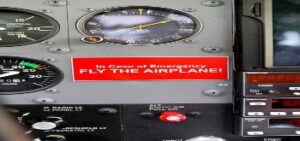
I learned early on in flight training about practicing emergencies just like all new students do, and I have wondered if others may ask, Why Do Pilots Practice Emergencies?
Why Do Pilots Practice Emergencies?
We practice emergency procedures in all sizes of aircraft from the Hang Glider to a Boeing or Airbus, to ensure that we complete each item in the correct sequence. While we must commit some items in certain aircraft to memory, they aim to assure safety and possibly a remedy, such as an engine failure and possible restart.
1. What Qualifies As An Emergency?
a. Medical emergencies that threaten the life of any soul on board, any serious illnesses, injury, heart attack, stroke, or severe allergic reaction.
b. A mechanical or electrical issue that threatens the safe outcome of the flight. This would be a flight control failure or engine failure or loss of pressurization. Any item that would threaten the safety of the passengers, or cargo. or aircraft.
c. Any security item that would require the immediate need to fly to the nearest airport.
d. Severe weather, like turbulence related to thunderstorms or severe clear air turbulence, or severe icing.
It is anything that could or would compromise the safety of the aircraft and its occupants.
2. What Do Pilots Practice in Emergency Training?
The final decision to declare an emergency remains with the pilot in command.
Practicing emergencies can be a lot of fun because they give you real-time scenarios that make you think and then follow procedures and checklists.
Today flight simulators create a safe environment for pilots to learn skills necessary for handling situations that compromise flight safety.
Items such as engine failure, engine fire, rapid decompression, electrical issues, and a host of other things that require immediate attention.
This teaches the pilot to learn to respond to unexpected events that could occur in flight. This assures the safety of the passengers and crew, cargo, and aircraft. Safe landings are nice.
We are all responsible for knowing the aircraft we fly intimately for our safety and our passengers.
3. How Does Emergency Training Help Pilots?
Learning emergency procedures gives pilots the knowledge and training to handle emergencies calmly and efficiently through repetitive activity.
This allows pilots to see firsthand in a simulator or aircraft what an aircraft will do when certain things go wrong.
When things go wrong in aircraft Unfortunately they go seriously wrong and the more experience that you have at handling those situations will severely impact the outcome of that emergency.
4. Teamwork. Crew Resource Management.
Some situations occur with Airline Crews that require all members of the team from the pilots to the flight attendants that need everyone’s attention to coordinate skills that are essential to the safety of the flight.
This type of training has become more and more prevalent and has had success while the safety of flight continues to be phenomenal.
These training sessions are essential and unnecessary for smooth transitions if any type of intervention or emergency is necessary.
This type of training is good for even two-pilot crews allowing Pilots to work together while in the cockpit.
Mistakes can be serious but with training, each pilot will know exactly what the role is and therefore helps reduce the stressful situation.
5. Decision Making.
Emergencies can be extremely stressful and training in proper decision-making will help reduce the stress and workload considerably. Everyone is on the same page.
This makes for an even flow within the cockpit dealing with an emergency and then finding the proper checklist and going through each portion of the checklist.
Good decisions are very essential in assuring the safest outcome of the flight. Pilots must make good decisions under extreme stress and practicing these kinds of emergencies and procedures help reduce the chance of making the wrong decision.
Because there are so many variables that can occur Pilots must be ready to manage multiple tasks during an emergency and this type of training certainly reduces the chance of making the wrong decision.
Final Thoughts.
Practicing emergencies is simply a great tool for Pilots to use for being ready for any kind of situation that may arise.
When you have practiced, let us say engine out procedures, and you lose an engine there isn’t any hesitation about what needs to be done and there isn’t time to panic because you’re too busy thinking about what you must get done.
So you do it, and it’s a far safer environment than finding a checklist to find out what to do.
That breeds PANIC, and that is never good in an aircraft
I loved practicing emergencies at Boeing in full-motion simulators.
All of the practice that I did over the years in engine-out procedures paid off one night when I was flying across Montana with the CEO of the company on board the aircraft.
I lost the right engine in hard IFR conditions about 30 miles to the east of Great Falls, Montana.
I had the privilege of having a very qualified first officer with me and between the two of us, we succeeded in landing in Great Falls, Montana safely.
There is no question that our training and practice saved our lives that night.
You could get an Instructor who could make things unrecoverable so you could see how it feels to lose control and crash.
Continuous improvement:
Emergency training is not a one-time event but an ongoing process. Pilots regularly undergo recurrent training to refresh their knowledge and skills. This continuous improvement helps pilots stay up-to-date with the latest procedures, technologies, and best practices related to emergency response.
Related: How Do We Reduce Pilot Error Accidents? (5 Topics To Ponder)